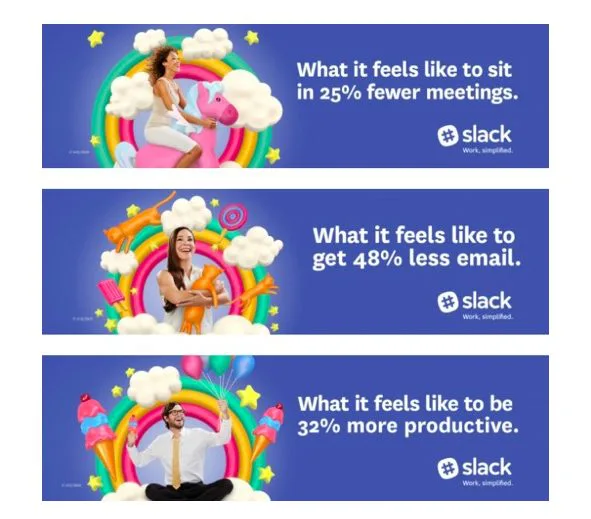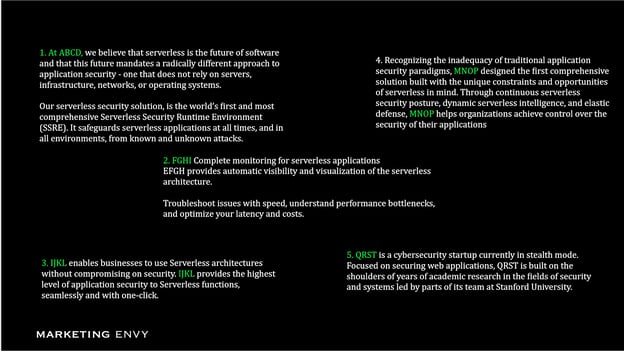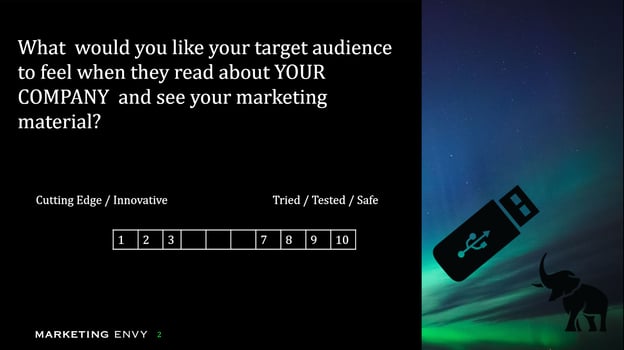
5 Steps To Having Kick-Ass B2B Messaging
Ah messaging… The often overlooked aspect of B2B marketing. In today’s marketing environment, the need for leads, MQLs, SQLs and any other QL you can think of is at a premium. As marketers, we are sometimes so hyper-focused on ensuring the bottom of funnel KPIs are met, that we overlook the most basic principle of B2B marketing - Ensuring you have the right B2B messaging that speaks to your target audience.
As the backbone of every piece of SEO content you create, be it a blog, webinar or even a plain old social media post, the importance of consistent B2B messaging cannot be overstated. Even a great product won’t make up for poor messaging. And it doesn’t matter if your business has existed for 3 months or 3 years, it’s critical to get your messaging right.
Let’s take a look at an example from Slack - A business platform which aims to enhance business communications. As a professional service, such companies would typically use a more “suit-and-tie” approach. However, this Slack ad speaks directly to the user benefit of their platform - increased productivity and less meetings.

This quote from digital marketing consultant Maureen Hall sums up the importance of getting your messaging right: Business-to-business work is about building a brand from the inside out. The brand message that we communicate to our clients’ business constituents is often the same message that is then carried through to the consumers in the marketplace.
Now, that’s all well and good. But how do you get to a position where your B2B messaging becomes a living, breathing creature which everyone in the company buys into. Read on to find out.
Crafting the ultimate B2B messaging
1. Testing your messaging: Do you have a B2B messaging problem?
The first step is often one of the most difficult - Testing your messaging with company executives...
This is because, while your messaging might not be bad, but chances are it isn’t great. This is very often a challenge for founders and company executives to realize. Let’s play a simple game that can help.
Step 1: Cut’n’paste your current messaging and the messaging of 4-5 of your competitors onto one slide
Step 2: Remove all company names
Step 3: Here’s the cool part - Invite your management team to identify your own positioning statement and also that of each competitor
Step 4: Once they have done so, add the names of the companies; watch and listen as everyone in the room sheepishly acknowledges that you do, in fact, have a messaging problem.

At that point you have 2 options - do a mic drop and walk out of the room… Or get working on crafting kick-ass messaging that will leave your competitors green with envy. If you choose the latter, it’s time to move onto step 2.
Watch our free, on-demand webinar to see if you have a B2B messaging problem!
2. Decide what type of company and personality you want your brand to portray
It’s crucial that, from the get-go, everyone is clear about the direction and tone of voice you wish to portray in the market. There are many ways to achieve this but one of our favorites is through asking some simple questions, and then on a scale of 1-10 deciding where your company fits in. These questions often include:
- Do you want to use a serious tone of voice, or be more playful and personable?
- Do you want to portray an air of exclusivity, or be accessible to all?
- Do you want to be seen as cutting-edge, constantly breaking boundaries and pushing limits, or a safe, tried and tested option?
If you do this using 2 brands from the same industry - For example Ferrari and Volvo, you can quickly see certain patterns start to emerge. One screams exclusivity, the other screams reliability.

Hot tip: NEVER, under any circumstances allow your business to occupy places 4-6 on the chart… This is known as the home of bland marketing, where even the best products/services are doomed to fail.
3. Setting up and running a B2B messaging workshop
One of the key ways to get your messaging right is ensuring you are not personally attached to a particular tone of voice. If you are, you run the risk of failing to see the messaging for what it could potentially be - Bland or meaningless.
If you can remove your emotions from the situation, great! If not, perhaps it is time to turn to some experts with experience of successfully running messaging campaigns for B2Bs.
A messaging workshop is a great way to ensure alignment between your brand, product and tone of voice. We usually recommend 3-5 people are involved in this from key functions - Such as sales and marketing, as well of course the founder and CEO (without their buy-in it will be difficult to run with the new and improved messaging!). The goal of a messaging workshop is to identify, through group discussion, what the overarching message your company will portray in the marketplaces. It is not about talking about how many benefits you offer, but rather getting to the core of why customers choose you.
4. Timelines and the dreaded messaging by committee 😨
Having goals for these sessions and a working timeline is crucial - This is why we generally recommend between 3-5 people are involved… It’s a lot easier to stick to timelines when each person is accountable. Also, the more people involved, the more likely you run the risk of reaching messaging by committee. This is where the amount of contrasting opinions make your messaging even less profound than it was when you started.
In other words, when your messaging passes through 10 pairs of hands before it returns to you, it will have been watered down so far that it’s neither recognizable nor memorable.
As the saying goes…. Too many chefs spoil the broth.
5. Over-explaining every benefit... Aka messaging FOMO!
We get it - Your product is great and you want to tell the entire world about it. While this may seem a logical conclusion, the chances are that most of your audience doesn’t care about what features your product has or how it’s “next-gen”... They simply want a solution that speaks to their needs and wants in a simple way. Instead of cramming everything into your messaging, you should aim to answer what is the SINGLE customer problem you solve. If your messaging does not clearly answer that. Start again. This can be extremely challenging for owners and CEOs, but as marketers we recognize that less is very often more - And this rings true when it comes to B2B messaging.
Tying it all together
B2B messaging follows on from your businesses core values, and informs everything your company does - From the website design to the content you create and the brand image you portray. Having clarity will not only make it easier for your team to speak to your customers actual pain point, it will also make your marketers lives easier as they can speak exactly to your customers pain points with unwavering clarity.
The beauty of all this is that you’ll know if your messaging is hitting, or falling wide of the mark. Once you have decided on your messaging, then the real work starts - Testing its validity. It’s important to remember you may not always get it right the first time, and that your messaging is to be a living breathing document. It can evolve over time as you better understand the market, what they care about, and what they don’t.
If this sounds very complex, you’re not alone. Contact us to see how we can help!






